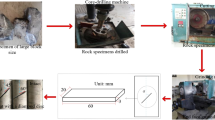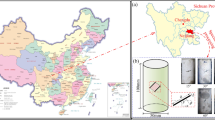Abstract
Hydraulic fracturing has been extensively utilized to control strata in coal mines. However, the mechanical characteristics and damage evolution of the fracturing rock mass have not been thoroughly explored. In this study, the effects of fracture dip angle on sandstone mechanical properties, failure modes, energy characteristics, and damage progression were investigated through uniaxial compression and acoustic emission monitoring systems. The results indicate that with the increase in the fracture angle, the compressive strength and elastic modulus of sandstone display an asymmetrical “U”-shaped change trend, and the failure mode of the sample is a mixed tension-shear failure. Throughout the loading process, the acoustic emission ringing counts and energy signals were imperceptible in the early stages, but rapidly increased to the peak value as the sample approached failure. Moreover, the acoustic emission amplitude signal showed the phase characteristic of active-calm-reactive to the peak point. With the increase in fracture inclination, the total strain energy and elastic energy at the peak point of sandstone also show an asymmetric “U”-shaped change trend. The energy storage capacity, dissipation capacity, and energy release intensity of the rock were characterized using a quadratic function relationship with the crack angle, θ, indicating that the difficulty of rock failure driven by energy follows a difficult-easy-difficult trend. In addition, a coupling damage model considering macro cracks and micro defects was established, demonstrating that the theoretical results are in good agreement with the experimental results.
Highlights
-
The mechanical properties and acoustic emission characteristics of sandstone with different crack angle were exposed.
-
Acoustic emission amplitude parameters can better reveal the impact of crack angle on rock progressive failure.
-
A coupling damage model considering macro cracks and micro defects was established and optimized.
-
The results could provide a basis for rock strength prediction and stability monitoring with defects.













Similar content being viewed by others

References
Chen Y, Guo BH (2020) Crack closure effect and energy dissipation model for rocks under uniaxial compression. Geotech Geol Eng 38:621–629. https://doi.org/10.1007/s10706-019-01051-4
Chu YP, Zhang DM, Liu H, Wu XY, Zhai PP, Sheng T (2022) Experimental study on mechanical properties, acoustic emission characteristics and energy evolution of coal samples after freezing with liquid nitrogen. Fuel 321:123955. https://doi.org/10.1016/j.fuel.2022.123955
Deng HF, Qi Y, Li JL, Assefa E, Li XZ (2021) Degradation mechanism of intermittent jointed sandstone under water-rock interaction. Chin J Geotech Eng 43(4):634–643 ((in Chinese))
Duan MK, Jiang CB, Yin WM, Yang K, Li JZ, Liu QJ (2021) Experimental study on mechanical and damage characteristics of coal under true triaxial cyclic disturbance. Eng Geol 295:106445. https://doi.org/10.1016/j.enggeo.2021.106445
Feng YJ, Kang HP (2012) Directional hydraulic fracturing controlled coal mine hard and difficult to collapse roof test. Chin J Rock Mech Eng 31(06):1148–1155 ((in Chinese))
Gong FQ, Luo S, Yan JY (2018) Energy storage and dissipation evolution process and characteristics of marble in three tension-type failure tests. Rock Mech Rock Eng 51(11):3613–3624. https://doi.org/10.1007/s00603-018-1564-4
Gong FQ, Yan JY, Luo S, Li XB (2019a) Investigation on the linear energy storage and dissipation laws of rock materials under uniaxial compression. Rock Mech Rock Eng 52(11):4237–4255. https://doi.org/10.1007/s00603-019-01842-4
Gong FQ, Yan JY, Li XB, L S (2019b) A peak-strength strain energy storage index for rock burst proneness of rock materials. Int J Rock Mech Min Sci 117: 76-89. https://doi.org/10.1016/j.ijrmms.2019b.03.020
Guéguen Y, Sarout J (2011) Characteristics of anisotropy and dispersion in cracked medium. Tectonophysics 503(1–2):165–172. https://doi.org/10.1016/j.tecto.2010.09.021
Hu HR, Xia BW, Luo YF Peng JJ (2022) Energy characteristics of sandstones with different crack angles under true triaxial cyclic loading and unloading. Energy Sci Eng. https://doi.org/10.1002/ese3.1110
Huang BX, Wang YZ, Cao SG (2015) Cavability control by hydraulic fracturing for top coal caving in hard thick coal seams. Int J Rock Mech Min Sci 74:45–57. https://doi.org/10.1016/j.ijrmms.2014.10.011
Jaeger JC (1960) Shear failure of anisotropic rocks. Geol Mag 97:65–72. https://doi.org/10.1130/0016-7606(1961)72[985:ESOSFI]2.0.CO;2
Kong B, Wang E, Li Z, Wang X, Liu J, Li N (2016) Fracture mechanical behavior of sandstone subjected to high-temperature treatment and its acoustic emission characteristics under uniaxial compression conditions. Rock Mech Rock Eng 49(12):4911–4918. https://doi.org/10.1007/s00603-021-02509-9
Kumari WGP, Ranjith PG, Perera MSA, Li X, Li LH, Chen BK, Isaka BLAD, Silva VRS (2018) Hydraulic fracturing under high temperature and pressure conditions with micro CT applications: geothermal energy from hot dry rocks. Fuel 230:138–154. https://doi.org/10.1016/j.fuel.2018.05.040
Lei R, Wang Y, Zhang L, Liu BL, Long K, Luo P, Wang YK (2019) The evolution of sandstone micro-structure and mechanical properties with thermal damage. Energy Sci Eng 7:3058–3075. https://doi.org/10.1002/ese3.480
Lei R, Zhang Z, Berto F, Ranjith PG, Zhang C (2021) Strain localization and cracking behavior of sandstone with two gypsum-infilled parallel flaws. Theor Appl Fract Mech 102873. https://doi.org/10.1016/j.tafmec.2020.102873
Liang X, Hou P, Xue Y, Gao YN, Gao F, Liu J, Dang FN (2022) Role of fractal effect in predicting crack initiation angle and its application in hydraulic fracturing. Rock Mech Rock Eng. https://doi.org/10.1007/s00603-022-02940-6
Liu XS, Ning JG, Tan YL, Gu QH (2016) Damage constitutive model based on energy dissipation for intact rock subjected to cyclic loading. Int J Rock Mech Min 85:27–32. https://doi.org/10.1016/j.ijrmms.2016.03.003
Liu Y, Dai F (2018) A damage constitutive model for intermittent jointed rocks under cyclic uniaxial compression. Int J Rock Mech Min Sci 103:289–301. https://doi.org/10.1016/j.ijrmms.2018.01.046
Pan J, Wu X, Guo Q, Xi X, Cai M (2020) Uniaxial experimental study of the deformation behavior and energy evolution of conjugate jointed rock based on AE and DIC methods. Adv Civ Eng 2020:1–16. https://doi.org/10.1155/2020/8850250
Pan JF, Ma WT, Liu SH, Gao JM (2021) A prevention technology of rock burst based on directional presplitting of water jet prefabricated slot in hard roof. Chin J Rock Mech Eng 40(08):1591–1602 ((in Chinese))
Pan C, Xia BW, Zuo YJ, Y B, Ou CN (2022) Mechanism and control technology of strong ground pressure behaviour induced by high-position hard roofs in extra-thick coal seam mining. Int J Rock Mech Min Sci https://doi.org/10.1016/j.ijmst.2022.01.006
Peng J, Rong G, Cai M, Zhou CB (2015) A model for characterizing crack closure effect of rocks. Eng Geol 189:48–57. https://doi.org/10.1016/j.enggeo.2015.02.004
Peng K, Wang Y, Zou Q, Liu Z, Mou J (2019) Effect of crack angles on energy characteristics of sandstones under a complex stress path. Eng Fract Mech 218:106577. https://doi.org/10.1016/j.engfracmech.2019.106577
Qiao C, Song Z, Wang Y, Tannant DY Li CH (2022) Fractures and Acoustic Emission Features of Non-persistent Jointed Rocks Subjected to Freeze–Thaw-Compression Load: Experimental Insights. Rock Mech Rock Eng 55: 109-123. https://doi.org/10.1007/s00603-021-02667-w
Rasouli Maleki M, Narimani Dehnavi R (2018) Influence of discontinuities on the squeezing intensity in high in situ stresses (a tunnelling case study; actual evidences and TBM release techniques). Rock Mech Rock Eng 51(9):2911–2933. https://doi.org/10.1007/s00603-018-1476-3
Ríos-Bayona F, Johansson F, Mas-Ivars D (2021) Prediction of peak shear strength of natural, unfilled rock joints accounting for matedness based on measured aperture. Rock Mech Rock Eng 54:1533–1550. https://doi.org/10.1007/s00603-020-02340-8
Singh S (1988) Burst energy release index. Rock Mech Rock Eng 21:149–155. https://doi.org/10.1007/BF01043119
Wang G, Zhang Y, Jiang Y (2018) Shear behaviour and acoustic emission characteristics of bolted rock joints with different roughnesses. Rock Mech Rock Eng 51:1885–1906. https://doi.org/10.1007/s00603-018-1438-9
Wang J, Li Y, Song WD, Xu WB (2019) Analysis of damage evolution characteristics of rock mass with different dip angles. J Harbin Inst Tech 51(08):143–150 ((in Chinese))
Wang CL, He BB, Hou XL, Li JY, Liu L (2020a) Stress-energy mechanism for rock failure evolution based on damage mechanics in hard rock. Rock Mech Rock Eng 53:1021–1037. https://doi.org/10.1007/s00603-019-01953-y
Wang GL, Wen XX, Zhang L (2020b) Dip effect of energy evolution mechanism of jointed sandstone under uniaxial compression. J Cent South Uni 51(07):1913–1923 ((in Chinese))
Wang J, Li JT, Shi ZM (2022) Deformation damage and acoustic emission characteristics of red sandstone under fatigue–creep interaction. Theor Appl Fract Mech 117:103192. https://doi.org/10.1016/j.tafmec.2021.103192
Wen T, Liu YR, Yang CG, Yi XL (2017) A rock damage constitutive model and damage energy dissipation rate analysis for characterising the crack closure effect. Geomech Geoeng Int J 13(1):54–63. https://doi.org/10.1080/17486025.2017.1330969
Xie HP, Ju Y, Li LY (2005) Criteria for strength and structural failure pf rocks based on energy dissipation and energy release principles. Chin J Rock Mech Eng 17:3003–3010 ((in Chinese))
Xu XL, Gao F, Zhang ZZ (2017) Thermo-mechanical coupling damage constitutive model of rock based on the Hoek-Brown strength criterion. Int J Damage Mech 27(8):1213–1230. https://doi.org/10.1177/1056789517726838
Yang SQ, Chen M, Tao Y (2021) Experimental study on anchorage mechanical behavior and surface cracking characteristics of a non-persistent jointed rock mass. Rock Mech Rock Eng 54:1193–1221. https://doi.org/10.1007/s00603-020-02325-7
Yang SQ, Jing HW (2011) Strength failure and crack coalescence behavior of brittle sandstone samples containing a single fissure under uniaxial compression. Int J Fract 168:227–250. https://doi.org/10.1007/s10704-010-9576-4
Yu B, Duan HF (2014) Study if roof control by hydraulic fracturing in full-mechanized caving with high strength in extra-thick coal layer. Chin J Rock Mech Eng 33(04):778–785 ((in Chinese))
Weibull W (1951) A statistical distribution function of wide applicability. J. Appl. Mech. 18 293–297.
Acknowledgements
This work was supported by the National Natural Science Foundation of China (Grant No. 51974042), and the Shanxi Science and Technology Plan Announced Bidding Project (Grant No. 20191101015).
Author information
Authors and Affiliations
Corresponding author
Ethics declarations
Conflict of interest
The authors declare that they have no known competing financial interests or personal relationships that could have appeared to influence the work reported in this paper.
Additional information
Publisher's Note
Springer Nature remains neutral with regard to jurisdictional claims in published maps and institutional affiliations.
Rights and permissions
Springer Nature or its licensor holds exclusive rights to this article under a publishing agreement with the author(s) or other rightsholder(s); author self-archiving of the accepted manuscript version of this article is solely governed by the terms of such publishing agreement and applicable law.
About this article
Cite this article
Xia, B., Li, Y., Hu, H. et al. Effect of Crack Angle on Mechanical Behaviors and Damage Evolution Characteristics of Sandstone Under Uniaxial Compression. Rock Mech Rock Eng 55, 6567–6582 (2022). https://doi.org/10.1007/s00603-022-03016-1
Received:
Accepted:
Published:
Issue Date:
DOI: https://doi.org/10.1007/s00603-022-03016-1



